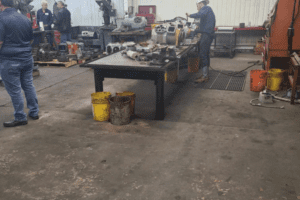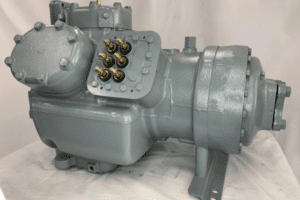Industrial refrigeration is the backbone of the food supply chain as we know it. Still, every refrigeration system ultimately relies on the same components. They’ve become more sophisticated with time, but still play familiar roles. Among those components, one stands out.
If you want to optimize your industrial refrigeration system, it’s crucial to understand the compressor.
What an Industrial Compressor Is and Does
The compressor is the most important component in any type of refrigeration system. It is often called the “heart” of the system because it does all the mechanical work necessary to make the refrigerant available to other components. When the system is running, the compressor is always active.
When other components aren’t operating at peak efficiency, the compressor works harder to reach the required performance. But the same is not true in reverse: When the compressor goes down, so does the system itself. To deliver results, the compressor must be supplied with the right kind of refrigerant.
The Role of Refrigerants in Industrial Refrigeration
For refrigerant gas to be distributed through a system, the compressor needs to increase its pressure. There are many different ways this can be done. Reciprocating compressors use pistons to compress gas, for instance, while screw compressors use two closely mated rotors that do not touch.
One concept that can be difficult to grasp is that, in many cases, no “cooling” is happening at all. Instead, heat is being transferred from place to place through the medium of the refrigerant gas. It must be able to change from liquid to vapor and back as it traverses the system.
While the compressors of the past were typically limited in what kind of refrigerant they could use, a modern compressor may be compatible with a wide range of refrigerants. Over the years, refrigerant formulations have changed to mitigate environmental harm and reduce hydrofluorocarbons.
Some industrial refrigerants include:
1. R-134a HFC Refrigerant
R-134a has a stake in the market as the replacement for halocarbon R12, which was phased out starting in 1987 under the Montreal Protocol. It is currently used in commercial refrigeration applications across the globe but is expected to be sunset as manufacturers shift to the production of newer alternatives.
2. R-404a HFC Refrigerant Blend
R-404a replaced halocarbons R502 and R22 and can also be used as a replacement for R12. Among the current roster of refrigerants, it has some of the highest global warming impact. Over time, legacy equipment utilizing R-404a is likely to be phased out.
3. R-744 Carbon Dioxide
R-744 is popular in both commercial grocery stores and ice rinks, where cooling needs are intensive and the area to be served can be vast. In the largest buildings, R-744 is used in centrifugal compressors. It can also be found in more compact compressors that serve refrigerated transport fleets.
R-744 presents a favorable safety profile in comparison to the highly toxic ammonia or flammable hydrocarbons. It can only be used under especially high pressures. All components and piping must be engineered to handle enhanced stress.
4. Ammonia
Ammonia is also a common industrial refrigerant of the day and is absolutely essential to agriculture, meatpacking, dairies, breweries, and large cold storage warehouses. It is nearly 20% more efficient than Freon but must be monitored closely due to safety risks.
Other Key Components of Industrial Refrigeration Systems
Aside from the compressor, there are several other critical components of an industrial refrigeration system. These systems come in single-stage and two-stage models, with various ways to feed the liquid into the evaporators. In most systems, a reciprocating or screw compressor is used.
Other vital components include:
1. Evaporator
The evaporator absorbs heat from the environment or industrial process targeted for cooling. As heat transfers into the refrigerant, the liquid is vaporized. Specialized pressure valves and pumps are needed to ensure the efficient operation of the evaporator when ammonia is used as the refrigerant.
2. Condenser
The condenser rejects heat the refrigerant absorbed elsewhere in the system, namely at the evaporator and compressor. Here, superheated refrigerant vapor makes a state change back into a liquid as excess heat energy is transferred out of it. The condenser may be air-cooled, water-cooled, or evaporative.
Keep Your Industrial Refrigeration System Working with Remanufactured Commercial Compressors
Every component in an industrial refrigeration system is impacted by the performance and efficiency of the compressor. Remanufactured commercial compressors give you the excellence you need at a deep discount – 10%, 20%, or even 30% less than you would get from an OEM-affiliated wholesaler.
With appropriate maintenance, lubrication, and refrigerant, you can expect anywhere from eight to ten years of hard work from a remanufactured industrial compressor. That makes a big difference in cost savings and value, especially among the demanding applications that industrial refrigeration is known for.












